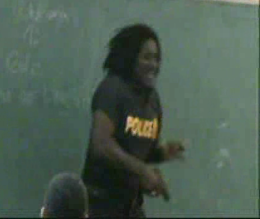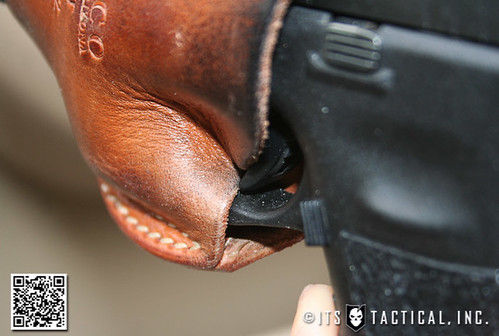
I think its time to go over some of the more advanced issues that come along with concealed carry on daily basis. This is a topic that is rarely covered. We learn in classes how to shoot, but safety is limited to the basic rules. “Treat guns as if loaded, keep your finger off the trigger guard, keep your gun pointed in a safe direction, ok lets start shooting!” Usually there’s not much emphasis placed on it after the rules are quickly reminded.
Lets start by defining some concepts here. Administrative handling would be the manipulation of the firearm that isn’t specifically shooting. This would include weapon disassemble, holstering, chambering a round or removing it among others. This elemental type of activity will become a part of your daily life if you carry concealed on daily basis.
One of the most dangerous incidents that could take place when handling a firearm is a negligent discharge or non-intended discharge. These are generally considered “accidental discharges”, but there’s a difference between the two.
Negligent Discharges: These occur when due to lack of responsibility or proper firearms safety instruction, the user discharges the weapon when he’s not intending to do so. Unfortunately this is pretty common. A good example would be tragedies were children ( or adults that act like one) shoot a friend “by accident” with a firearm left unsupervised. There’s simply no excuse for negligent gun handling. Joking, “playing” or general fooling around with a firearm clearly shows that such person lacks the maturity to handle one. Negligent discharges are the ones that most often end in severe injury or death. Due to its nature, in this case its very likely that all firearm safety rules have been broken simultaneously with terrible results. Lack of knowledge isn’t an excuse either. If you don’t know how to drive, you don’t attempt to drive for the first time on a highway where you know you’ll likely injure yourself and others. It’s the same thing with a gun.
This should not be confused with cases were the operator of the firearm shoots someone he’s not supposed to. Pulling the trigger with full intention, the operator shoots a loved one or innocent person, failing to properly identify the target during a stressful incident. Incorrectly called accidents, these mostly occur due to lack of proper firearms training specifically oriented to self-defense shooting. Unfortunately many defensive shooting schools these days have instructors with military back ground that don’t put as much attention in proper target ID, preferring the more appealing high speed low drag experience that makes students feel better about themselves.
Non-intended discharge: Ever got surprised by a second shot after shooting the first one? That’s a non-intended discharge. The difference between non-intended and negligent discharge is that in this case the operator has firearms safety knowledge and does handle the firearm as he’s supposed to. In spite of handling the firearm with the respect it deserves and having adequate firearms training, a non-intended discharge is possible based on human error. No one is perfect. Even though you do everything right, you can’t avoid making a mistake eventually. Dry firing with a suddenly loaded gun, pulling the trigger to disassemble a striker firing pistol (Glock) while forgetting a round in the chamber are good examples.
Discharges due to Mechanical Failure: These are very rare in the gun world. Even though some confuse these with non-intended or negligent discharges, the difference is very clear and worth noticing so as to use the right terminology. In this case, there’s no human error, the guns fails you. With modern firearms this is rare but occasionally happens. Rifles or handguns that fire when the safety is removed would be an example. Some Remignton 700 rifles experience this problem and have been recalled.
Safe Administrative Handling.
Its said that everyone that handles firearms eventually has at the very least a non-intended discharge sooner or later. If it didn’t ever happen to you just wait a while. Handling weapons on frequent basis means its just a matter of time until it happens so never drop your guard.
What can be done then, since its pretty much unavoidable?
What you can do is a) Respect the basic firearms handling rules b) Create an administrative handling routine that reduces the risk in case of a non-intended discharge as much as possible.
A good routine for a person that carries a gun on daily basis could be:
1) Never handle the firearm with other people in the room, especially children. Say you put on your weapon and holster when dressing, always close the door of your room when doing so. Same thing when putting the gun away for the night. Even if left handy, the removing of the holster from your belt and leaving the gun in a safe but accessible place, that can be done with the door locked to minimize risk to other family members.
2) Have a routine for chambering a round. Again, with the door locked, always do it with the gun pointed in a safe direction, where the projectile wouldn’t penetrate through walls. This could be a gun safe or a wooden dresser with some paper magazines in the direction your pointing the gun at. Always do it in this same direction, especially when you have to pull the trigger on an empty chamber in your Glock. If you do this all the time, when your non intended discharge eventually happens you’ll be putting that round into a bunch of magazines rather than through the wall and across the kid’s room.

3) The gun stays in the holster. If you’re traveling or have to remove the gun from your belt, always leaving it in its holster. The holster is actually an integral part of the Glock system. A Glock will not fire while inside an adequate holster. There have been some accidents with leather holsters deforming and catching on the trigger when reholstering. I prefer polymer holsters to avoid this. Still, check your holster often for cracks or deformation and don’t hurry when reholstering, do it slowly.
4) When dry fire practicing, put the ammo away, don’t leave a magazine full near by. All you need is a phone call , someone calling you and distracting you for a second for you to load that mag, chamber a round and then continue your dry fire practice… this happens A LOT. When dry firing, do it when no one is around, kids and wife out of the house. Either that or practice it at the range. Always do it in a safe direction. Dry firing with your family running around if inviting disaster.
Following the basic rules and developing a safe routine for you administrative handling will reduce the chances of injury or even fatal accidents due to accidental discharges as much as humanly possible.
Take care!
FerFAL
Join the forum discussion on this post
.








6 comments:
very nice, I'd like to remind your readers of the risk of bullet setback.
When you unload your weapon and then rechamber the round that was previously chambered again (defensive ammo sure is expensive right) you run the risk of pushing the bullet further into the case. This may not be an issue if it only happens a few times but every time the bullet is seated deeper the volume of the case is reduced and the pressure created when the round fires is increased.
daily practice is fantastic and dry fire practice is a wonderful thing but be careful if you constantly rechamber that round it will eventually get a shorter overall length.
Nice article! It covered all the things your apartment neighbors want you to know about gun safety.
There are public safety campaigns about everything from condoms to clean water here that go into great detail. Gun safety messages are limited to "They're dangerous and we don't really know why you want one, but keep it unloaded and locked away." (Useless in an emergency.)
I'd like to see a public safety campaign focus on gun safety instruction being as sensible as learning to operate your new chain saw. People generally ask an experienced friend or read the instructions about those; of course you need to find out the specifics of your new model. How is a gun any different?
Pop N Fresh - thanks for the tip. I don't carry loaded, so I frequently practice draw and chamber. I just pulled out my glock 33, dropped the mag and looked at the round that's at the top round compared to the one behind it (quality defensive round) - and the bullet is at least 1/8th of an inch farther back. OK - so that one comes out and becomes the practice round for draw/chamber drills - thanks.
A better way to practice the draw and chamber if that's what you want to do is to make or buy some dummy rounds/snap caps. That way you don't have to worry about an AD.
I would have to see the ballistics to believe that 'bullet setback' has any noticeable effect whatsoever on pressure or velocity. I reloaded for many many years and never experienced a problem with this issue. I fired an average of 2000 rounds a month over a five year period. Then we began also handling fully automatic weapons and that number tripled.
This is an excellent article, I am going to have my husband read it. The advice is very clear and sobering. Thank you.
Post a Comment